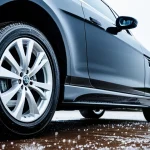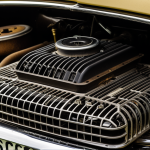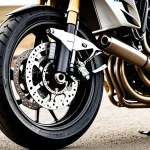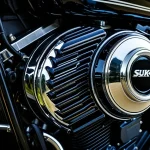Understanding Overheating Risks in Vintage British Convertibles
Owning a vintage British convertible offers undeniable charm but comes with unique challenges, particularly around overheating. These classic models often feature cooling systems that differ significantly from modern counterparts, and understanding these nuances is crucial for maintaining your car’s integrity.
Overheating in such vehicles can manifest through symptoms like steam exiting from the bonnet, erratic temperature gauge readings, or unusual engine noises. Ignoring these signs can escalate risks, leading to severe damage. For instance, persistent overheating might cause warped cylinder heads or a compromised radiator, wreaking havoc on the historic engine and contributing components.
En parallèle : Enhancing Lane-Keeping Assist: Tailoring Vehicle Configurations for Optimal Performance on UK Rural Roads
To mitigate these risks, acquaint yourself with the car’s cooling system and tailor prevention strategies accordingly. Vital actions include routine checks, utilising high-quality coolants, and adhering to specified lubricant grades. Familiarity with what’s normal versus abnormal in performance is also invaluable, ensuring potential overheating risks are managed swiftly. Maintaining a proactive stance in addressing such issues helps preserve both the vehicle’s functionality and its market value, making your classic car ownership experience as delightful as possible.
Essential Maintenance for Cooling Systems
Vintage car maintenance requires special attention, especially regarding the cooling systems. Regular inspections are crucial to prevent issues with radiator care and ensure the vehicle remains in optimal condition. It is essential to conduct both visual inspections and preventative checks to catch potential problems early.
Lire également : Enhance Your Hybrid’s Fuel Efficiency with These Winter Driving Tips in the UK
Using the correct coolant is vital in maintaining a healthy cooling system. Check the coolant’s condition regularly to ensure it is not contaminated or depleted. A clean and effective coolant is necessary to prevent blockages and overheating. Additionally, it’s advisable to follow the manufacturer’s guidelines for coolant specifications and replacement intervals.
Flushing the cooling system is another critical step in maintenance, effectively removing debris and sediment that can lead to blockages. Performing a flush requires the vehicle to be cool and involves draining the old coolant, cleaning the radiator, and refilling with fresh coolant. Proper maintenance of the cooling system not only aids in preventing overheating but also prolongs the life of the vintage British convertible, enhancing its performance and preserving its value.
Diagnosing Cooling System Problems
Diagnosing issues in a vintage British convertible’s cooling system is essential to prevent engine overheating. Start by examining the system for leaks or flow issues. Signs of leaking coolant or reduced flow can indicate a compromised radiator or hoses, leading to overheating. Use a pressure tester to efficiently pinpoint leakage areas.
Check the thermostat functionality next. Faulty thermostats can fail to open, restricting coolant flow and causing temperature spikes. Submerge the thermostat in water and heat it gradually, watching for the opening temperature alignment with specifications.
A failing water pump can significantly reduce cooling efficiency. Look for coolant leaks around the pump or unusual noises, like whining sounds, when the engine is running. A worn-out pump can hinder the coolant’s circulation, leading to overheating, especially on hot days.
Identifying these issues early helps maintain your convertible’s performance and longevity. Invest in the right tools and leverage classic car forums for troubleshooting tips. Experienced members can offer insights and suggest resources, ensuring that your engine runs smoothly under any conditions. Managing vintage cooling problems preserves both your vehicle’s mechanical health and historical value.
Effective Driving Techniques in Hot Weather
Understanding effective driving techniques in hot weather is crucial for protecting your vintage British convertible from overheating. Adjusting your speed and adopting specific driving habits can reduce the risk significantly. Maintaining a moderate speed and avoiding rapid acceleration helps keep the engine cool, as high speeds and abrupt driving increase thermal stress on the engine.
Strategic driving is essential to maintain optimal engine temperatures. Consider taking routes that avoid congested traffic, where prolonged idling can lead to overheating. Use the early mornings or late evenings for travel when temperatures are cooler. This also aids in easing the workload on your cooling system.
Refrain from using the air conditioning excessively. While comfortable, it increases the engine’s burden. Instead, roll down the windows when feasible. Route planning is also vital—opt for paths with less traffic to minimize being stationary for extended periods. Passing on these practices helps ensure your classic vehicle remains in top condition, allowing you to enjoy the open road without overheating concerns. Consequently, this proactive approach safeguards both your vehicle’s health and vintage appeal.
Upgrading Cooling Components
Enhancing the cooling components of your vintage British convertible can be a rewarding venture, especially when considering performance parts and vintage modifications. Upgrading from traditional to more efficient modern cooling enhancements is a wise choice. Components such as radiators and fans, when upgraded, can significantly improve cooling efficiency.
Consider radiator enhancements with increased capacity or those made from aluminum, offering better heat dissipation compared to the often heavier, original materials. Additionally, switching to electric cooling fans over mechanical ones can help manage engine temperatures more precisely and efficiently. This is particularly useful in stop-and-go traffic where overheating risks increase.
When contemplating these modifications, weigh the pros and cons of after-market versus original parts. While after-market options often provide enhanced performance, they may alter the vintage aesthetic of the vehicle. Balancing function with form is crucial in maintaining both the car’s performance and its classic appeal.
Ultimately, these enhancements can increase your vehicle’s reliability and longevity, ensuring enjoyable drives without compromising the car’s historic charm. Through thoughtful upgrades, you can protect your investment while savoring the vintage driving experience.
Community Resources and Expert Insights
Engagement with the Car Maintenance Community can be invaluable for tackling overheating in vintage British convertibles. Joining owner groups or forums offers rich insights, practical tips, and shared experiences from fellow enthusiasts. These platforms often host discussions on common overheating issues, solutions, and preventive measures specific to vintage models.
Seeking expert tips from seasoned mechanics specializing in classic cars can further mitigate risks. They provide valuable advice on leveraging cooling accessories and recommended brands for optimum performance. By consulting experts, owners can make informed decisions, enhancing their vehicle’s reliability.
Exploring owner experiences on forums like “Classic Car UK” or “MG Experience” can assist in troubleshooting unique problems. Members often share anecdotes that highlight effective troubleshooting tactics, such as the impact of route planning on engine health.
Local clubs frequently organize workshops and meetups, offering hands-on guidance and community support. This communal exchange not only enriches knowledge but fosters camaraderie among vintage car aficionados, ensuring both the preservation and enjoyment of these cherished vehicles. Through active participation, car owners can access a wealth of expertise, conferring both confidence and competency in managing overheating challenges.
Product Recommendations for Cooling Solutions
Selecting the right cooling products is crucial for preserving your vintage British convertible’s charm. Among the top-rated options are high-quality coolants and radiator maintenance kits. These products help in maintaining optimal engine temperatures and preventing overheating. Coolant additives, for example, not only boost engine performance but also enhance heat dissipation, reducing overall thermal stress on vintage components.
For those considering aftermarket cooling fans, these can be highly effective in improving airflow and managing engine temperature, especially during hot weather. Unlike traditional fans, modern electrical fans offer greater precision, providing a significant cooling advantage in traffic scenarios that tend to raise engine temperatures.
Additionally, hi-tech monitoring tools are invaluable for tracking engine temperature in real-time, enabling owners to react promptly to any arising cooling issues. These devices, often synchronized with smart apps, grant peace of mind by alerting you about critical temperature thresholds, thereby safeguarding your classic vehicle from potential damage.
When choosing cooling accessories, prioritize products with positive reviews and those recommended by experts in the vintage car community to ensure both reliability and performance.









